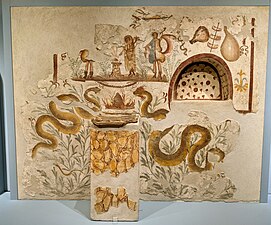Terzigno

Terzigno is a comune (municipality) in the Metropolitan City of Naples in the Italian region Campania, located about 20 km east of Naples. As of 31 December 2004, it had a population of 16,977 and an area of 23.5 km2.[3]
The municipality of Terzigno contains the frazione (subdivision) Boccia al Mauro.
Terzigno borders the following municipalities: Boscoreale, Boscotrecase, Ottaviano, Poggiomarino, San Giuseppe Vesuviano.
History


In Roman times Terzigno was an rural outlying suburb of Pompeii in which numerous aristocratic and rustic country villas were located and which were all buried and preserved beneath many metres of volcanic debris by the eruption of Mount Vesuvius in 79 AD.[4]
Excavations at Terzigno began in 1983 with the unearthing of three villas and work has continued sporadically since. Exquisite frescoes and were found and silver and gold objects including jewellery on five skeletons of people who failed to escape the eruption.[5]
The villas
Villa 6 is remarkable for its enormous and refined Second Style frescoes from a dining room representing mythological figures including Cybele and Attis as well as Paris and Helen at various ages.[6] In its last phase an agricultural part of the complex was added focussed on a winery with a large threshing floor and a columned portico, adjacent lever press (torcularium) and dolia in a wine cellar. Outside the NE entrance to the villa skeletons of seven fugitives were found.
The Museo Archeologico Territoriale di Terzigno has frescoes and finds from these local villas.
-
 villa 6: Lararium (domestic shrine) with niche and altar
villa 6: Lararium (domestic shrine) with niche and altar -
 Detail of Lararium
Detail of Lararium -
 Detail of Lararium
Detail of Lararium
Villa 1 of the 1st quarter of the 1st c. BC was in a particularly elegant residential neighbourhood but had a large wine cellar raised above ground level with 42 dolia and an area used for fodder storage and a threshing floor. The earthquake of 62 AD caused damage and restoration was still in progress at the time of the eruption, such as columns of the portico being rebuit in brick.[7]
Villa 2 of the late 2nd to early 1st century BC similarly had renovation work in progress and had a central courtyard with portico supported by brick pillars and columns on three sides. A large open area was probably a threshing floor. The skeletons of five people with gold jewellery, silverware and a hoard of republican and imperial silver coins were found here. The elegant workmanship of the silverware, together with the jewellery, denote their high social status. A wooden press (exactly as described by Cato[8]) with a large dolium for collecting the must was near a wine cellar with twenty-four dolia buried in the floor which was raised above the adjacent courtyard.
Demographic evolution

References
- ^ "Superficie di Comuni Province e Regioni italiane al 9 ottobre 2011". Italian National Institute of Statistics. Retrieved 16 March 2019.
- ^ "Popolazione Residente al 1° Gennaio 2018". Italian National Institute of Statistics. Retrieved 16 March 2019.
- ^ All demographics and other statistics: Italian statistical institute Istat.
- ^ TERZIGNO Enciclopedia dell' Arte Antica (1997) https://www.treccani.it/enciclopedia/terzigno_%28Enciclopedia-dell'-Arte-Antica%29/
- ^ Gestione Commissariale di Terzigno in 1989: "The Roman Villas of Terzigno" edited by Caterina Cicirelli.
- ^ PompeiiinPictures https://pompeiiinpictures.com/pompeiiinpictures/VF/Villa_065%20Terzigno%20Contrada%20Avini.htm
- ^ TERZIGNO Enciclopedia dell' Arte Antica (1997) https://www.treccani.it/enciclopedia/terzigno_%28Enciclopedia-dell'-Arte-Antica%29/
- ^ Cato the Elder, De Agri Cultura 18
- v
- t
- e
- Acerra
- Afragola
- Agerola
- Anacapri
- Arzano
- Bacoli
- Barano d'Ischia
- Boscoreale
- Boscotrecase
- Brusciano
- Caivano
- Calvizzano
- Camposano
- Capri
- Carbonara di Nola
- Cardito
- Casalnuovo di Napoli
- Casamarciano
- Casamicciola Terme
- Casandrino
- Casavatore
- Casola di Napoli
- Casoria
- Castellammare di Stabia
- Castello di Cisterna
- Cercola
- Cicciano
- Cimitile
- Comiziano
- Crispano
- Ercolano
- Forio
- Frattamaggiore
- Frattaminore
- Giugliano in Campania
- Gragnano
- Grumo Nevano
- Ischia
- Lacco Ameno
- Lettere
- Liveri
- Marano di Napoli
- Mariglianella
- Marigliano
- Massa Lubrense
- Massa di Somma
- Melito di Napoli
- Meta
- Monte di Procida
- Mugnano di Napoli
- Naples
- Nola
- Ottaviano
- Palma Campania
- Piano di Sorrento
- Pimonte
- Poggiomarino
- Pollena Trocchia
- Pomigliano d'Arco
- Pompei
- Portici
- Pozzuoli
- Procida
- Qualiano
- Quarto
- Roccarainola
- San Gennaro Vesuviano
- San Giorgio a Cremano
- San Giuseppe Vesuviano
- San Paolo Bel Sito
- San Sebastiano al Vesuvio
- San Vitaliano
- Sant'Agnello
- Sant'Anastasia
- Sant'Antimo
- Sant'Antonio Abate
- Santa Maria la Carità
- Saviano
- Scisciano
- Serrara Fontana
- Somma Vesuviana
- Sorrento
- Striano
- Terzigno
- Torre Annunziata
- Torre del Greco
- Trecase
- Tufino
- Vico Equense
- Villaricca
- Visciano
- Volla

 | This Campanian location article is a stub. You can help Wikipedia by expanding it. |
- v
- t
- e













